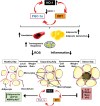Heme Oxygenase-1 Upregulation: A Novel Approach in the Treatment of Cardiovascular Disease
- PMID: 31891663
- PMCID: PMC7153645
- DOI: 10.1089/ars.2019.7970
Heme Oxygenase-1 Upregulation: A Novel Approach in the Treatment of Cardiovascular Disease
Abstract
Significance: Heme oxygenase (HO) plays a pivotal role in both vascular and metabolic functions and is involved in many physiological and pathophysiological processes in vascular endothelial cells (ECs) and adipocytes. Recent Advances: From the regulation of adipogenesis in adipose tissue to the adaptive response of vascular tissue in the ECs, HO plays a critical role in the capability of the vascular system to respond and adjust to insults in homeostasis. Recent studies show that HO-1 through regulation of adipocyte and adipose tissue functions ultimately aid not only in local but also in systemic maintenance of homeostasis. Critical Issues: Recent advances have revealed the existence of a cross talk between vascular ECs and adipocytes in adipose tissue. In the pathological state of obesity, this cross talk contributes to the condition's adverse chronic effects, and we propose that specific targeting of the HO-1 gene can restore signaling pathways and improve both vascular and adipose functions. Future Directions: A complete understanding of the role of HO-1 in regulation of cardiovascular homeostasis is important to comprehend the homeostatic regulation as well as in cardiovascular disease. Efforts are required to highlight the effects and the ability to target the HO-1 gene in models of obesity with an emphasis on the role of pericardial fat on cardiovascular health.
Keywords: adipocytes; cardiovascular disease; heme oxygenase; obesity; oxidative stress.
Figures






References
-
- Abraham NG, Drummond GS, Lutton JD, and Kappas A. The biological significance and physiological role of heme oxygenase. Cell Physiol Biochem 6: 129–168, 1996
-
- Abraham NG and Kappas A. Pharmacological and clinical aspects of heme oxygenase. Pharmacol Rev 60: 79–127, 2008 - PubMed
-
- Abraham NG, Rezzani R, Rodella L, Kruger A, Taller D, Li VG, Goodman AI, and Kappas A. Overexpression of human heme oxygenase-1 attenuates endothelial cell sloughing in experimental diabetes. Am J Physiol Heart Circ Physiol 287: H2468–H2477, 2004 - PubMed
Publication types
MeSH terms
Substances
LinkOut - more resources
Full Text Sources
